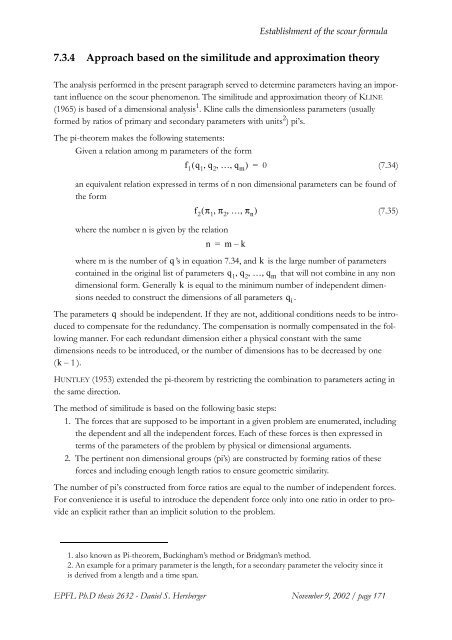pdf, 12 MiB - Infoscience - EPFL
pdf, 12 MiB - Infoscience - EPFL
pdf, 12 MiB - Infoscience - EPFL
You also want an ePaper? Increase the reach of your titles
YUMPU automatically turns print PDFs into web optimized ePapers that Google loves.
Establishment of the scour formula<br />
7.3.4 Approach based on the similitude and approximation theory<br />
The analysis performed in the present paragraph served to determine parameters having an important<br />
influence on the scour phenomenon. The similitude and approximation theory of KLINE<br />
(1965) is based of a dimensional analysis 1 . Kline calls the dimensionless parameters (usually<br />
formed by ratios of primary and secondary parameters with units 2 ) pi’s.<br />
The pi-theorem makes the following statements:<br />
Given a relation among m parameters of the form<br />
f 1<br />
( q 1<br />
, q 2<br />
,…,<br />
q m ) = 0<br />
(7.34)<br />
an equivalent relation expressed in terms of n non dimensional parameters can be found of<br />
the form<br />
f 2<br />
( π 1<br />
, π 2<br />
,…π , n )<br />
where the number n is given by the relation<br />
n = m – k<br />
(7.35)<br />
where m is the number of q’s in equation 7.34, and k is the large number of parameters<br />
contained in the original list of parameters q 1<br />
, q 2<br />
,…,<br />
q m that will not combine in any non<br />
dimensional form. Generally k is equal to the minimum number of independent dimensions<br />
needed to construct the dimensions of all parameters .<br />
The parameters q should be independent. If they are not, additional conditions needs to be introduced<br />
to compensate for the redundancy. The compensation is normally compensated in the following<br />
manner. For each redundant dimension either a physical constant with the same<br />
dimensions needs to be introduced, or the number of dimensions has to be decreased by one<br />
( k – 1 ).<br />
HUNTLEY (1953) extended the pi-theorem by restricting the combination to parameters acting in<br />
the same direction.<br />
The method of similitude is based on the following basic steps:<br />
1. The forces that are supposed to be important in a given problem are enumerated, including<br />
the dependent and all the independent forces. Each of these forces is then expressed in<br />
terms of the parameters of the problem by physical or dimensional arguments.<br />
2. The pertinent non dimensional groups (pi’s) are constructed by forming ratios of these<br />
forces and including enough length ratios to ensure geometric similarity.<br />
The number of pi’s constructed from force ratios are equal to the number of independent forces.<br />
For convenience it is useful to introduce the dependent force only into one ratio in order to provide<br />
an explicit rather than an implicit solution to the problem.<br />
q i<br />
1. also known as Pi-theorem, Buckingham’s method or Bridgman’s method.<br />
2. An example for a primary parameter is the length, for a secondary parameter the velocity since it<br />
is derived from a length and a time span.<br />
<strong>EPFL</strong> Ph.D thesis 2632 - Daniel S. Hersberger November 9, 2002 / page 171
















